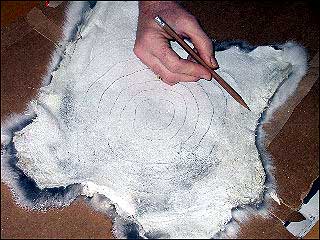
"First, I want to tell you how wonderful the finished blanket is: it is extremely luxurious, light weight (4 lbs) and yet exceedingly warm, soft, and supple. We consider this blanket one of our most prized possessions. You feel like you're snuggling up with 50 soft, cuddly rabbits whenever you want. If you choose to make one you will not regret it."
Materials needed:
50 rabbit skins
250 feet cotton cordage
Spindle to hold wound furs
4 lengths of 2 inch diameter wood for the frame (two 4 foot lengths
and two 5.5 foot lengths) and strong cordage to lash the frame
together.
1) Obtain hides. Use raw jack rabbit hides or tanned
rabbit hides
Tanned rabbit skin hides can be ordered through http://www.chichesterinc.com:
phone 800-206-6544, price $1.50 each (as of January 3, 2003) plus
shipping.
2) We used 50 tanned rabbit hides to make the 3 feet by 4.5 feet blanket photographed in this article.
3) Mark your hides into a spiral from the center outward to the edge that is 1 inch wide.

4) Using a utility knife to cut the hides. Hold the hide off the table to avoid cutting off fur.
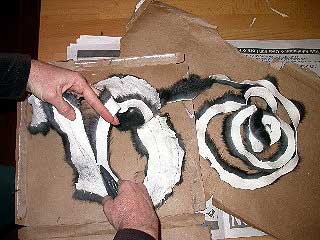
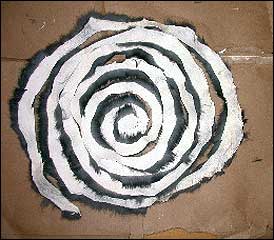
5) Attach the fur to something that you will wind the twisted fur onto. We used a plastic spindle made for a large electrical cord, but a 2 foot section of a 2 inch diameter branch would do.
6) Attach your spindle to an object to hold it tight. We pinched it inside a drawer.
7) Now twist the fur strips, folding them in half, fur side out, and roll them up onto the spindle.
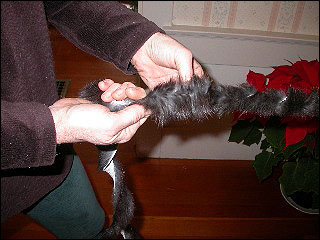
8) Join the strips by cutting a small 3/4 inch slit in both ends of each strip of fur, one inch from the ends of the strip. Slip one end of the untwisted strip of fur into the slit through the twisted strip of fur. Pull the untwisted strip through its own slit and pull tight. This will lock the two strips together.

9) Continue joining and twisting your skins until all skins are completed.
10) Now build a frame out of 2 inch diameter branches or 2 inch by 2 inch lumber that are at least 4 feet by 5.5 feet. Use strong cordage to bind each corner of the frame.
11) Attach one end of your twisted and joined hides with a cordage to one of the 4 foot side of your frame.
12) Wrap the twisted hides around and around the two shorter sides of the frame until all hides are wound onto the frame.
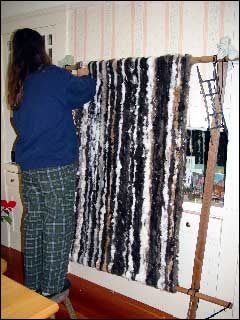
13)  Now starting
at the bottom of the frame, using cotton cordage, TWINE the fur
strips together every 1.5 inches from left to right (or right
to left). We used a length of cordage that was approximately 18
feet long. Starting from the left hand side of the frame tie the
middle of this cordage onto the first strip of fur. Then twist
the cordage once around itself on the other side of the first
strip. Then weave in and out of each fur wrapping the cordage
around itself before and after each strip of fur. Tie off the
cordage ends to the fur strip at the far side of the frame. Now,
repeat this twining every 1.5 inches until you reach the top.
This twining is very important. If you were to simply weave the
cordage it would not stay put nor would it hold the strips in
a uniform twisted shape.
Now starting
at the bottom of the frame, using cotton cordage, TWINE the fur
strips together every 1.5 inches from left to right (or right
to left). We used a length of cordage that was approximately 18
feet long. Starting from the left hand side of the frame tie the
middle of this cordage onto the first strip of fur. Then twist
the cordage once around itself on the other side of the first
strip. Then weave in and out of each fur wrapping the cordage
around itself before and after each strip of fur. Tie off the
cordage ends to the fur strip at the far side of the frame. Now,
repeat this twining every 1.5 inches until you reach the top.
This twining is very important. If you were to simply weave the
cordage it would not stay put nor would it hold the strips in
a uniform twisted shape.
14) Remove from the frame and enjoy!
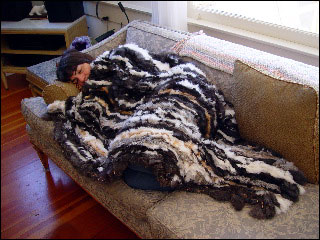
Compared to a wool blanket, a rabbit blanket is surprisingly warm: being about 1" thick rather than a wool blanket which is most often quite thin. Warmth in thickness. The photo below (from the book The Native Americans by Colin F. Taylor) is of an authentic rabbit skin blanket.
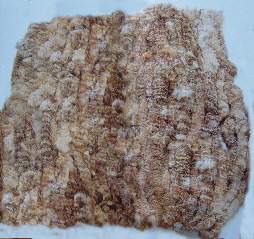
For more information on making a rabbit skin blanket out of raw jack rabbit hides, see the book entitled, Survival Arts of the Primitive Paiutes, by Margaret M. Wheat (pages 75 - 77). Jimmy George (Paiute) demonstates the process of skinning, twisting, and twining together the long spiral strips of raw rabbit pelts.
Also, read the e-mail
response by Susan Witmore pertaining to questions on the use
of raw jack rabbit hides to make a rabbit skin blanket.
E-mail your comments to "Bob Gillis" at bob@shelter-systems.com
We hope the information on the PrimitiveWays website is both instructional and enjoyable. Understand that no warranty or guarantee is included. We expect adults to act responsibly and children to be supervised by a responsible adult. If you use the information on this site to create your own projects or if you try techniques described on PrimitiveWays, behave in accordance with applicable laws, and think about the sustainability of natural resources. Using tools or techniques described on PrimitiveWays can be dangerous with exposure to heavy, sharp or pointed objects, fire, stone tools and hazards present in outdoor settings. Without proper care and caution, or if done incorrectly, there is a risk of property damage, personal injury or even death. So, be advised: Anyone using any information provided on the PrimitiveWays website assumes responsibility for using proper care and caution to protect property, the life, health and safety of himself or herself and all others. He or she expressly assumes all risk of harm or damage to all persons or property proximately caused by the use of this information.
© PrimitiveWays 2013